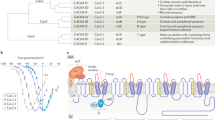Abstract
SYNAPTIC release of glutamate results in a two component excitatory postsynaptic current (e.p.s.c.) at many vertebrate central synapses1–6. Non-N-methyl-D-aspartate receptors mediate a component that has a rapid onset and decay while the component mediated by N-methyl-D-aspartate (NMDA) receptors has a slow rise-time and a decay of several hundred milliseconds, 100 times longer than the mean open time of NMDA channels7–9. The slow decay of the NMDA-mediated e.p.s.c. could be due to residual glutamate in the synaptic cleft resulting in repeated binding and activation of NMDA receptors. However, in cultured hippocampal neurons, we find that the NMDA receptor antagonist D-2-amino-5-phosphonopentanoate has no effect on the slow e.p.s.c. when rapidly applied after activation of the synapse, suggesting that rebinding of glutamate does not occur. In addition, a brief pulse of glutamate to an outside-out membrane patch results in openings of NMDA channels that persist for hundreds of milliseconds, indicating that glutamate can remain bound for this period. These results imply that a brief pulse of glutamate in the synaptic cleft is sufficient to account for the slow e.p.s.c.
This is a preview of subscription content, access via your institution
Access options
Subscribe to this journal
Receive 51 print issues and online access
$199.00 per year
only $3.90 per issue
Buy this article
- Purchase on Springer Link
- Instant access to full article PDF
Prices may be subject to local taxes which are calculated during checkout
Similar content being viewed by others
References
Forsythe, I. D. & Westbrook, G. L. J. Physiol., Lond. 396, 515–533 (1988).
Westbrook, G. L. & Jahr, C. E. Seminars in the Neurosciences 1, 103–114 (1989).
Dale, N. & Roberts, A. J. Physiol., Lond. 363, 35–59 (1985).
Bekkers, J. M. & Stevens, C. F. Nature 341, 230–233 (1989).
Collingridge, G. L., Herron, C. E. & Lester, R. A. J. J. Physiol., Lond. 399, 283–300 (1988).
Hestrin, S., Nicoll, R. A., Perkel, D. J. & Sah, P. J. Physiol., Lond. 422, 203–225 (1990).
Nowak, L., Bregestovski, P., Ascher, P., Herbet, A. & Prochiantz, A. Nature 307, 462–465 (1984).
Jahr, C. E. & Stevens, C. F. Nature 325, 522–525 (1987).
Cull-Candy, S. G. & Usowicz, M. M. Nature 325, 525–528 (1987).
Blake, J. F., Brown, M. W. & Collingridge, G. L. Neurosci. Lett. 89, 182–186 (1988).
Andreasen, M., Lambert, J. D. C. & Jensen, M. S. J. Physiol., Lond. 414, 317–336 (1989).
Kauer, J. A., Malenka, R. C. & Nicoll, R. A. Neuron 1, 911–917 (1988).
Wigstrom, H., Gustafsson, B. & Huang, Y-Y. Acta physiol. scand. 124, 475–478 (1985).
Sernagor, E., Kuhn, D., Vyklicky, L. & Mayer, M. Neuron 2, 1221–1227 (1989).
Mayer, M. L., Westbrook, G. L. & Guthrie, P. B. Nature 309, 261–263 (1984).
Colquhoun, D. & Ogden, D. C. J. Physiol., Lond. 395, 131–159 (1988).
Patneau, D. K. & Mayer, M. L. J. Neurosci. (in the press).
Olverman, H. J., Jones, A. W. & Watkins, J. C. Nature 307, 460–462 (1984).
Colquhoun, D., Large, W. A. & Rang, H. P. J. Physiol., Lond. 266, 361–395 (1977).
Trussell, L. O. & Fischbach, G. D. Neuron 3, 209–218 (1989).
Tang, C. M., Dichter, M. & Morad, M. Science 243, 1474–1477 (1989).
Forsythe, I. D. & Clements, J. D. J. Physiol., Lond. (in the press).
Lester, R. A. J., Quarum, M. L., Parker, J. D., Weber, E. & Jahr, C. E. Molec. Pharmac. 35, 565–570 (1989).
Author information
Authors and Affiliations
Rights and permissions
About this article
Cite this article
Lester, R., Clements, J., Westbrook, G. et al. Channel kinetics determine the time course of NMDA receptor-mediated synaptic currents. Nature 346, 565–567 (1990). https://doi.org/10.1038/346565a0
Received:
Accepted:
Published:
Issue Date:
DOI: https://doi.org/10.1038/346565a0
This article is cited by
-
Therapeutic potential of N-methyl-D-aspartate receptor modulators in psychiatry
Neuropsychopharmacology (2024)
-
Role of NMDAR plasticity in a computational model of synaptic memory
Scientific Reports (2021)
-
The Role or NMDA Receptors in Epileptogenesis
Neuroscience and Behavioral Physiology (2021)
-
Post-stimulatory activity in primate auditory cortex evoked by sensory stimulation during passive listening
Scientific Reports (2020)
-
Biased modulators of NMDA receptors control channel opening and ion selectivity
Nature Chemical Biology (2020)
Comments
By submitting a comment you agree to abide by our Terms and Community Guidelines. If you find something abusive or that does not comply with our terms or guidelines please flag it as inappropriate.



